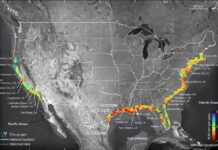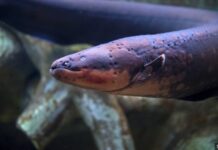By Simon Li and Eric Yang
What Are Lichens?
Lichens are defined as a symbiotic relationship between a fungi and a photobiont (symbiont capable of photosynthesis), usually algae. Instead of a singular organism. Usually, the fungus assumes a dominant role in the relationship with most of a lichen’s characteristics coming from the fungus. The fungus is made up of filamentous (thin) cells called hyphae which pack together to form a distinct structure, called the thallus. There is clear stratification between parts of the fungus, which can be divided into the cortex at the very top acting as protection, the algal zone where the photobiont is held, the medulla, made up of loosely compacted hyphae, the lower cortex, and rhizines at the very bottom to help anchor the lichens in place. Lichens can live for hundreds of years undisturbed, however, are very sensitive to pollution and environmental changes. As a result, many lichens are used as environmental indicators to monitor the level of pollution in a given area.
To get a better understanding of lichens, however, let us now examine the individual organisms that make up lichens.
Fungi are a kingdom made up of eukaryotic spore-producing organisms that are filamentous and are heterotrophic. As already mentioned, fungi are made up of cells called hyphae, which can often have multiple nuclei to compensate for their long length. They can vary drastically when it comes to size – from tiny yeasts all the way up to a massive 2,384 acre (3.5 miles) large Armillaria ostoyae found in Oregon. There are over 144 thousand species of fungi all around the world, including mushrooms, yeasts, and molds, and they are incredibly important to the ecosystem. They can be found by themselves or often in a symbiotic or parasitic relationship with other organisms.
Fungi are often mistaken for plants due to their rooted nature and the presence of cell walls. However, what differentiates these two is the fact that fungi lack chlorophyll and thus the ability to photosynthesize. In addition, many components of the cell structure and function between the two are drastically different such as the presence of chitin in fungal cells and the storage of energy using glycogen as opposed to amylose. As a matter of fact, fungi are more closely related with the animal kingdom than the plant kingdom.
Algae is a term used to categorize photosynthetic eukaryotic (with a nucleus) organisms with them generally lacking specific structures such as roots, stems, leaves and vascular tissue. Due to their ambiguous definition, there still exists debate on the taxonomy and classification of algae into a certain kingdom. Many forms of “algae” that lichen are made out of do not fit the definition of a “photosynthetic eukaryotic organism” as they are cyanobacteria, which are prokaryotes (lacking a nucleus). As a result, the definition of lichen is broader than just “a symbiotic relationship between a fungus and algae” and the term “photobiont” is used. Further discussion of the definition of lichens is mentioned further in the article.
However, the same criticism applies to algae. Since no concrete definition of it exists, a more specific examination of algae is required. The top two algal species that make up lichens are green algae and blue-green algae, otherwise known as cyanobacteria. Green algae is another informal grouping of algae that have chlorophyll a and b within their chloroplasts, giving them a green coloration. There exists about 22 thousand species of green algae. Blue-green algae are a species of gram negative bacteria (equipped with a thin peptidoglycan cell wall) that derive their name from their blue-green color. Unlike most bacteria, however, blue-green algae possess internal cell membranes with the existence of thylakoids. Inside these thylakoids exist a variety of chlorophylls accepting, you guessed it, blue and green light. Cyanobacteria have an important history as well – scientists believe that they are responsible for oxygenating the earth, essentially “rusting” the earth, causing aerobic life to flourish and anaerobic life to suffer. There exists about 2698 known species of blue-green algae, with models predicting around 6000 species in total.
As fungi lack the necessary components for photosynthesis, it relies on the algae or cyanobacteria for food. The algae and/or Cyanobacteria can photosynthesize and create their own food while the fungus focuses on growing, expanding, and protecting the algae. The symbiotic relationship between fungi and photobiont are demonstrated once more as the oxygen and sugars produced by photosynthesis is often used by the fungi for cellular respiration, and the carbon dioxide produced in cellular respiration is used by the photobiont for photosynthesis. Nutrients gathered from the photobiont are usually stored in the medulla of the lichen.
Types of Lichen
There are over 13 thousand different species of lichen, with there being three main categories: fruticose, crustose, and foliose lichens.
Crustose lichens are marked by their, well, crusty appearance. They are two dimensional, growing out in a flat plane along the surface they are attached to. As a result, removal of the lichen is nearly impossible and will result in the death of said lichen. The growth rate of crustose lichens is extremely slow even among lichens, with the highest level of growth correlating to high moisture levels. They may even play a role in the weathering of certain rocks.
Fruticose lichens are known for their branched growth that looks like fingers. They appear erect or hanging, fully three dimensional (grows out in 3 planes), and look almost like root structures. They are most commonly found in forests, mountains, and the arctic tundra. There are often more of these types of lichen on the tops of structures rather than the bottom, as younger, faster growing lichens are found often near the top of said structures. For example, fruticose lichens will be more prevalent on tree tops rather than at the base of the tree.
Foliose lichens are characterized by their leafy appearance, and are considered halfway between crustose and fruticose lichens. They grow in a three dimensional manner, however in a sheeted form rather than a root structure. Unlike their crustose cousins, foliose lichens often are not completely attached to their substrate, making their bottoms visible. These lichens are also responsible for the weathering of many rocks, and are found from dry mountains to wet valleys. Their lifespans are relatively short compared to others, ranging between 30 to 60 years. Other lichens have been estimated to be as old as 5,000 years old.
A prolific lichen enthusiast has probably also heard of the terms “macrolichens” and “microlichens” before, however both are essentially misnomers. The terms do not deal with a lichen’s size, but rather its growth form, with macrolichens accounting for foliose and fruticose lichens and microlichens accounting for crustose lichens. Further confusion may be prompted when a microlichen is vastly larger in size than a macrolichen. As one will see throughout this article, there is virtually no end to the loose definitions of anything lichen related.
Reproduction
There are many different ways a lichen can reproduce asexually through vegetative reproduction, however some can also reproduce sexually. Lichens can also spread by simply growing or drying up and spreading themselves, without the need for reproduction.
Asexual reproduction is characterized by the offspring having the same genetic information as the parent organism, and leads to less genetic variation but increased reproduction, whereas in sexual reproduction, two parent organisms are required to combine half of their genetic information each together, resulting in increased genetic variation but slower reproduction. In a lichen however, the only part that can reproduce sexually, is the fungal partner. The apothecia is the primary structure that facilitates sexual reprodction in fungi, which is done through spores. These spores themselves are not the offspring, but essentially lichen reproductive cells which must pair up with a photobiont in order to create a new lichen.
Vegetative reproduction is defined as asexual reproduction characterized by offspring which starts off as a small growth on the parent organism and then eventually falling off, with the offspring being genetically the same as its parent. For example, a part of a lichen thallus can fall off and can grow into a new lichen. Other, more specialized forms of vegetative reproduction include using soredia and isidia, which are tiny offshoots on the thallus that contain a mixture of photobiont and fungal cells and can be broken off easily.
Ecology
Found nearly everywhere (8% of the earth’s surface), lichen can grow on a variety of surfaces such as bark, leaves, moss, rocks, soil, bones, and even other lichens. Lichens have been known to survive the harshest of harsh climates, with many having adapted to live in the barren landscape of Antarctica.
An important feature of lichen ecology is their role as colonizers. Lichens are often one of the first species to inhabit areas previously devoid of life, for example in areas after a volcanic eruption or in a massive wildfire. Being nutrient poor and lacking proper conditions for plant life, lichens are one of the only species capable of surviving in those barren landscapes. Their efforts often pave the way for the eventual flourishing of entire ecosystems in the region, as they contribute to the weathering and erosion of the area and deposit their gathered precious nutrients when they eventually die.
Lichens are also an important food source for many animals, especially in the arctic tundra where plant life is scarce. The most well known lichen munchers are reindeer and caribou, who depend on it during winter months where other food sources are unavailable. These animals can consume roughly 7 to 11 pounds of lichen per day, as its protein content is quite low. In addition, many birds utilize lichens in building their nests, to provide camouflage to their humble abode. Lichens are also treated like a delicacy in some species of crabs, as noted by Australian lichenologist Patrick McCarthy. On Christmas Island, McCarthy spotted a red crab delicately eating the lichen Ramalina dumeticola for several minutes. Humans also make great use out of lichens, discussed below in the human usage section.
Lichens are commonly believed to kill plants, especially trees. However, extensive research across the years have come across no conclusive evidence to pin the death of plants to the lichen growing on them. As lichen themselves grow very slowly, they prefer to latch onto similarly slow-growing plants, such as older, dead or dying trees.
As stated before, lichens are extremely sensitive to pollution and are an indicator species, being one of the first to be impacted by environmental destruction. They derive almost all of their nutrients directly from atmospheric deposition, which means that any pollutants in the air will be absorbed by the lichen as well. An example is nitrogen pollutants, which destroys the lichen algae’s chlorophyll and can kill the colony. The health of lichen can be monitored to provide an assessment of the pollution situation of a wide area, as lichen are common and plentiful.
Human usage
Humans have been taking advantage of lichens since the Middle Ages. Red and purple dye could be obtained from the acids in lichens Roccella and Ochrolechia. The Native Americans used vulpinic acid from the pine lichen to create a bright yellow dye. Lichens can also be used as an ingredient in perfume. The extracts of both Oak moss and Pseudevernia furfuracea are popular in deodorants and perfumes, and Pseudevernia was even used to stuff Egyptian mummies.
With proper preparation, lichens can become edible as well. They are indigestible as is, but it is possible to cook lichen that has been partially digested by deer as a delicacy. Most lichen dishes are found in China, where their consistency is deemed “rubbery” and is thus fried, boiled, and/or pressure cooked. However, many lichens are toxic and one should not consume them without proper knowledge and guidance.
A new definition
Stunning new research released recently has helped shed light on the outdated definition of lichens as the symbiotic relationship between a mycobiont (fungus) and a photobiont, coined in 1868 by Simon Schwendener, a Swiss botanist. For example, in their new paper, Contrasting co-occurrence patterns of photobiont and cystobasidiomycete yeast associated with common epiphytic lichen species, co-authors Kristiina Mark, Lauri Laanisto, C. Guillermo Bueno, Ülo Niinemets, Christine Keller, and Christoph Scheidegger found the presence of yeasts in several species of lichen in Europe. While previous research had pinpointed the same results, finding the presence of yeasts in lichen symbiotes, the findings had been ambiguous and under controversy. Further studies were not in agreement, with some suggesting that the yeasts were indeed part of the lichen, while others disagreed with the conclusion.
Using ITS primers (such as ITS4) and PCR tests, the researchers sequenced and compared lichen fungal and photobiont cells as well as yeasts from 25 sites from Switzerland and Estonia and found the frequent presence of yeasts within lichens. However, the yeasts did not appear to be as uniformly distributed amongst lichen species as the corresponding photobionts did. While they acknowledged that further studies had to be done in order to be sure, the conclusion they did not reject was the inclusion of said yeasts in the lichen relationship.
A commentary of the study, written by David L. Hawksworth and Martin Grube, suggests that one should only be encouraged by the findings made by Mark, Laanisto, etc., and that the rabbit hole of redefining lichen must be explored further.
A quick look at their research stuns the reader – it is absolutely revolutionary! Hawksworth and Grube provide evidence that not only yeasts existed within the lichen, but bacteria, protists, and even viruses have been found occupying the open systems of the lichen. While the photobiont resides within the fungal layers, a vast variety of microorganisms are found to exist in the cortexes of the lichen, suggest the two researchers. In addition, a finding from 2011 concluded that lichen are actually strengthened with the presence of several photobionts, suggesting the same with other microorganisms as well. Thus, they redefine lichens as a “self‐sustaining ecosystem formed by the interaction of an inhabitant fungus and an extracellular arrangement of one or more photosynthetic partners and an indeterminate number of other microscopic organisms”.
For now, we eagerly await the arrival of new and exciting studies on the redefinition of lichens. We may never know the true definition of lichens, we may never even approach knowing all that there is to know about lichens. However, one thing remains certain – the promising future of lichen research. As the great American author, poet, and philosopher Henry David Thoreau put it beautifully, “There is a low mist in the woods—It is a good day to study lichens”.










